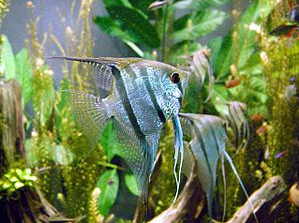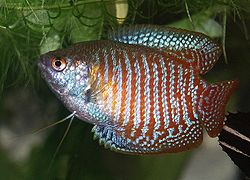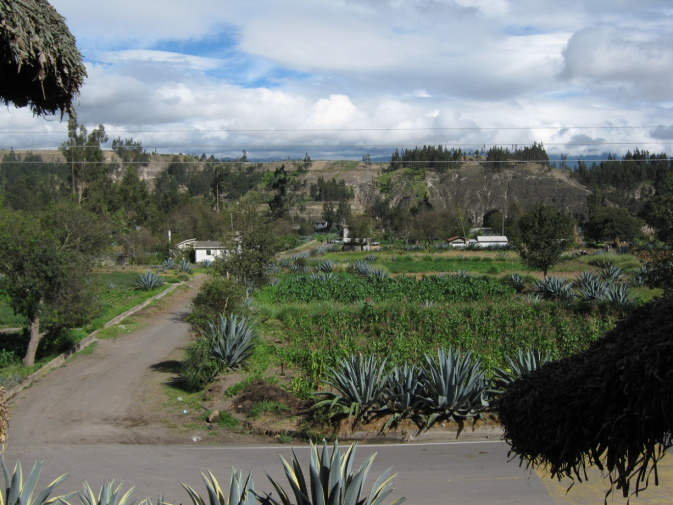pH
value with animals
<Optimal ist für die
meisten Lebewesen der Bereich zwischen 7,5 und
8,5.> [web01]
pH value in aquariums has to be different depending
of the fish
<In aquariums plants and fishes need certain pH
values in the water. There is a certain pH tolerance
but beyond the pH tolerance they cannot live. Mostly
the water plants in aquariums are more tolerants
concerning pH in the water than fishes are.
Guide values for freshwater aquarium fishes:
- sour water (pH ≈ 6):
- South "American" fishes (like neon fish,
anglefish, discus fish, L welses and others)
- Asian fishes (gourami fish and others)
- neutral water (pH ≈ 7)
- Central "American" fishes (firemouth cichlid
and others)
- basic alkaline water (pH ≈ 8)
- fishes from the East African trench lakes
(cichlids from Tanganyika lake and Malawi lake
and others).> [web02]

 Anglefish in sour water from South
"America" [2] - gourami fish in sour water from Asia
[3]
Anglefish in sour water from South
"America" [2] - gourami fish in sour water from Asia
[3]
pH value with soil
General connections with clay content etc.
The more clay the soil contents the more basic the
ground is [web03]:
<Optimal pH value of the soil is influenced by
kinds of plants, content of organic substances (humus
etc.) and by clay minerals. Thypical pH values in
agriculture are recommended here for example:
-- pH5.0 to pH5.5 with under 4% (<4%) organic
substance and <5% clay share
-- pH 5.4 to pH6.0 with 5 to 12% clay share
-- pH6.0 to 6.5 with over 13% (>13%) clay
share.> [web03]
Sour rain is buffered by soil and
is hardly changing any environment. [web03].
List: pH values of soils
Limestone powder pH10,0-11,0
[web03]
Lime marl
pH9,0-10,0
[web03]
Alkaline soils
pH8,0-9,0
[web03]
Lime shiver acre:
basic [web04]
Gravel path: basic [web04]
Neutral salty soils
(saline soils)
pH7,5-8,0
[web03]
calcerous low moors
pH7,0-7,5
[web03]
Lime marsh
pH7,0
[web03]
Black soils
pH6,5-7,0
[web03]
Coniferous forest: sour [web04]
Brown soils, little marsh
pH6,0-6,5
[web03]
Para brown earths,
tidal marsh pH5,0-6,0
[web03]
Podzol, moor marsh (bog marsh?)
pH4,0-5,0
[web03]
Hill moor
pH3,0-4,0
[web03]
Sour sulfate soils <
pH3,0
[web03]
pH values with soils, fruits and vegetables
Very basic alkaline soils can suffer under a lack of
mangane [web03].
A rise of pH value has generally an effect of
embetterment of the earthy framework [web03].
Cabbage needs basic alkaline earth [web03].
Field crops prefer neutral or slightly sour soils mostly
because of the solubility of most of nutrients between
pH6.4 and pH6.8 [web03].
Potatoes and strawberries need a sour soil [web03].
Very sour soils can provoke that too much aluminum is
released in toxic concentrations [web03].
Cultivation of fruits and vegetables according to
pH values in the soil
Spanish sainfoin 7.5-8.4 - bell bean 7.0-8.4 - lucerne
6.5 to 8.9 - asparagus
6.5-8.4 - clover, garden salad, onion 6.0-7.4 -
spinach 6.0-6.9 - olive tree 5.5-8.4 - wheat 5.5-7.9 -
white clover, sorghum, rye, peach, pear, apple, corn,
cucumber, cabbage, carrot, citrus fruits 5, 5-7.4 -
garden pumpkin, Trifolium Incarnatum, tomato 5.5-6.9 -
vetch 5.0-8.4 - barley, rice, soybean 5.0-7.9 -
tobacco from Virginia, wine 5.0-7.4 - bastard clover,
potato, bean, oat for seed 5.0-6.9 - strawberries 5.0-6.4
- blueberries 5.0-5.9 - cotton 4.5-6.9
- rhododendrons 4.5-5.9 [web03]
Cultivation
of fruits and vegetables according to pH
values in the soil - the list
Spanish sainfoin
7.5-8.4
bell bean 7.0-8.4
lucerne 6.5 to 8.9
asparagus 6.5-8.4
clover, garden salad, onion 6.0-7.4
spinach 6.0-6.9
olive tree 5.5-8.4
wheat 5.5-7.9
white clover, sorghum, rye, peach, pear,
apple, corn, cucumber, cabbage, carrot, citrus
fruits 5, 5-7.4
garden pumpkin, Trifolium Incarnatum, tomato
5.5-6.9
vetch 5.0-8.4
barley, rice, soybean 5.0-7.9
tobacco from Virginia, wine 5.0-7.4
bastard clover, potato, bean, oat for seed
5.0-6.9
strawberries 5.0-6.4
blueberries 5.0-5.9
cotton 4.5-6.9
rhododendrons 4.5-5.9 [web03]




